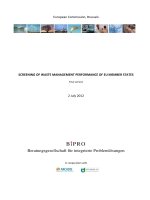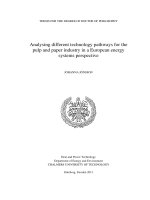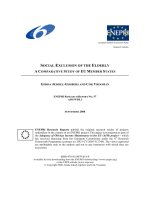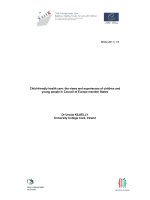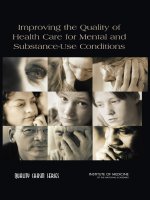Child-friendly health care: the views and experiences of children and young people in Council of Europe member States doc
Bạn đang xem bản rút gọn của tài liệu. Xem và tải ngay bản đầy đủ của tài liệu tại đây (1.2 MB, 22 trang )
MSN (2011) 1 E
Child-friendly health care: the views and experiences of children and
young people in Council of Europe member States
Dr Ursula KILKELLY
University College Cork, Ireland
2
Introduction
The Council of Europe guidelines on child-friendly health care are designed to provide a
framework to ensure that health care systems operate in line with best practice in children’s
health care and fulfil commitments under the United Nations Convention on the Rights of the
Child (UNCRC) and other international standards. At its meeting in December 2010, the
Committee of Experts mandated to draft the guidelines agreed to consult children and young
people on their opinions and experiences of health care. A literature review on the existing
research evidence on children’s rights in health care (completed by the author and submitted
to the Group in December 2010) noted that although much research had been undertaken,
especially in English-speaking countries, about children’s participation in clinical decision-
making, little was known about children’s experience of health care more broadly, including
their involvement as service-users. Moreover, the research noted that little was known about
children’s experiences of health care in certain parts of the Council of Europe. For this
reason, a Council of Europe consultation was planned, chiefly by means of a survey, with a
view to recording the views of as wide a group of children as possible. The survey was
developed, piloted on a small scale, and made available to the Council of Europe’s national
partners in the health care and children’s sectors. The survey was then placed on line at the
start of June 2011 where it was available in 14 languages. This report presents the findings
of that consultation process.
It is important that the Council of Europe has begun to involve children in its legal and policy-
making work. Children and young people have a right to have their voices heard and taken
into account in matters that affect them in accordance with Article 12 of the UNCRC, and in
this regard the Council of Europe has broken new ground at international level. This work is
not without its challenges – logistical and methodological – and it is important that the
Council of Europe and other organisations continue to learn from, and improve, their work in
this field. How the bodies who ask children and young people for their views respond to what
they tell us is crucial for the legitimacy of the consultation process and the trust children and
young people have in these types of initiatives. For this reason, this report does not attempt
to analyse or nuance what the children and young people have said about health care. It
presents their views in clear terms so that they can be taken into account by everyone who
reads this report.
Methodology
As noted above, the principal method used in this consultation process was a survey or
questionnaire. This method was chosen so that the greatest number of children and young
people could be reached, including through an online process. Most questions were phrased
3
with closed, multiple choice or tick-box answers, because despite the richness that open-
ended questions produce, the resources necessary to translate comments or answers were
not available. In one instance - Ireland – the Ombudsman for Children undertook five focus
group discussions with 125 children and young people aged between 9 and 12 years from a
variety of rural, city and disadvantaged backgrounds. Each group discussed their thoughts
on health care for children and also undertook an arts-based workshop during which children
had the choice of working individually or in groups to create posters that illustrated their
views and ideas. The posters appearing in this report are all taken from this process and they
vividly portray the views of all children who participated in this process. The five groups
consulted by the Ombudsman for Children focused on the health care setting and what could
make it more child-friendly, the attitudes and behaviours of health care professionals and
issues affecting communication and children’s use of health care services. Accordingly, their
report, which is incorporated here, not only presents the issues in the children’s own words
but also includes some their descriptions of their views and experiences in art form. This
data thus adds a welcome richness to this report and a special debt of gratitude is owed to
the Ombudsman for Children’s Office in Ireland for this work.
In all other cases, the surveys were completed by children and young people usually by
completing hard copies of the survey which were then sent to the Council of Europe for
processing. A small number of children also undertook to complete the survey online. All of
these surveys were processed and so the results are produced here together. Some national
partners have synthesised the data themselves and these were taken into account also for
the final report.
In total, 2,257 surveys were completed by children from the following countries: Armenia,
Austria, Bosnia and Herzegovina, Bulgaria, Estonia, Finland, France, Georgia, Germany,
Greece, Ireland, Italy, Malta, Netherlands, Poland, Portugal, Romania, Serbia, Slovakia,
Slovenia, Spain and the United Kingdom).
1
Children from 22 Council of Europe member states participated in the consultation about
their health care, meaning that a wide range of experiences should have been caught by the
survey. At the same time, it is important to highlight that a large proportion of the surveys –
almost half - were completed by children in Austria. The effect of this on the results is difficult
to determine given the range of variables at play in surveys of this kind. Moreover, it is
important to state that each child completed the survey in his/her own right and did not do so
1. 14 respondents did not answer this question.
4
as a representative of any other child or of children from a particular country or area. For this
reason, and because resources were limited, no weighting was applied to the results.
The survey
The survey is broken down into several sections. The first section asked the children about
themselves, where they were from, their age and circumstances.
Age
The majority of children who completed the survey (40.1%) were aged between 13 and 15
years. A further large proportion was between 16 and 18 years (33.1%) and smaller
proportions were between 10 and 12 years (19.1%) and under ten years (7.6%). As Figure 1
shows, good age ranges are thus represented in the survey, and so it can be said genuinely
to represent the views and experiences of children right across childhood (albeit with limited
reference to very young children). The consultation by the Ombudsman for Children’s Office
involved younger children, under 12 years, and so their views are well represented in this
context.
Figure 1: The age of the respondents
5
Gender
Gender was almost evenly split; 52.5% of respondents were male and 47.5% of respondents
were female.
Disability
The survey asked whether the respondents had a condition that limited their everyday
activities. The vast majority (84.8%) replied that they did not.
Happiness
The final question in this section asked the respondents to rate their happiness on a scale of
1 to 10 where 1 was very unhappy and 10 very happy. The largest number (31.4%) rated
themselves as very happy, with significant numbers giving their happiness at level 9 (15.6%);
8 (21.9%); 7 (13.5%), 6 (4.8%) and 5 (6.9%). As Figure 2 shows, very small numbers of
children considered themselves unhappy.
Figure 2: Children’s views about their own happiness
Health care visits
This part of the survey asked children about the frequency of their contact with the health
care system.
6
Frequency
Question 6 asked children how often they had been to see various health care professionals
in the last year (1-3 times; 4-6 times; 7-10 times and more often). They were provided with
various categories of health care professionals to choose from in each case. Most children
identified the least frequent option for each professional. For example, 62.1% of children had
been to see their doctor 1-3 times, with much smaller numbers of respondents visiting their
doctor more than three times in the last year. The same was true of nurses: 84.3% of
children had been to see a nurse 1-3 times in the last year; 72.6% had been to see a dentist
1-3 times, 75.7% had been to see a therapist (for example a physiotherapist, speech
therapist, etc.) and 82.1% of children had been to see a mental health counsellor or a
psychologist 1-3 times. In total, 69.2% said that they had seen another health professional
(the most common answers here were ophthalmic or gynaecological specialists) 1-3 times.
This information is presented in Figure 3 and gives a sense of the extent of respondent
children’s contact with health care in the last year.
Figure 3: Frequency of contact with the health care system
Who accompanied you to your visit?
The vast majority of children (84.5%) who completed the survey were accompanied to their
appointments by a parent or family member. Only 3% attended with a friend, while 11.8%
said that they went alone. A small number (0.8%) were accompanied by someone else and
the most popular answer here was ‘teacher’. The importance to children of their families in
this context is identified further below.
7
Last visit to a health care professional
The next series of questions asked about children’s last visit to see a health professional.
Which professional did you last visit?
Question 8 asked which professional the child had last visited. The largest number (43.5%)
indicated that this was a doctor, with a significant number (35.4%) indicating that they had
last visited a dentist. 11.9% of respondents said that their last contact with the system was
within a hospital setting, whereas smaller numbers of children told us that they had last
visited a therapist (3.3%), psychologist or counsellor (1.5%) or another category (4.3%),
which included an ophthalmic, dermatology or orthopaedic specialist.
Distance to the appointment
Question 9 asked whether they had travelled a short, medium or long distance (measurable
in time) to get to their last appointment with a health care professional. This question sought
to find out how far children had to travel to reach their health care professional and
importantly to obtain children’s perspective on this issue. The vast majority of respondents
(77.5%) said that it did not take long (less than 30 minutes) to reach their appointment.
However, almost one fifth (17.8%) said that it was a medium distance away – taking between
30 and 60 minutes - while 4.7% said that it was a long distance, taking more than one hour to
get there.
Figure 4: How long did children have to wait to be seen
8
Waiting time at the appointment
In Question 10, the children were asked how long they had to wait to be seen at their health
appointment. The majority (40.8%) of respondents said that the waiting time was short, that
they were seen in a few minutes. A further 28.9% said that the wait was medium in length –
not too long – whereas small numbers said that there was no wait at all involved (16.7%).
13.6% reported that they had to wait a long time. In the Irish consultations, most of the
children felt that the time they spent in waiting areas (a period of 1 ½ to 2 ½ hours was cited)
in advance of being seen by a health care professional was too long.
Waiting area
Question 11 sought to find out in simple terms whether the children were happy with the
waiting areas available to them. The majority of respondents (80.1%) said that the waiting
area was a good place to wait, while 19.1% said that it was not. The children consulted by
9
the Ombudsman for Children in Ireland suggested that waiting rooms used by children were
not adequately child-friendly.
Feeling
Question 12 asked the children what their strongest emotion was when they were waiting to
see the health care professional. For the highest proportion of children (37.5%), they felt
bored waiting for their appointment. Broadly similar numbers of respondents said that they
felt either relaxed (27.7%) or anxious (19.9%) during the waiting period, while 7.9% of
children said that they were in pain.
Figure 5: How did you feel while you were waiting?
The health care setting
Various elements of the survey touched on the physical nature of the health care setting and
the extent to which it meets children’s needs. This was particularly the case in the questions
concerning the hospital setting, explained below. In addition, the children consulted by the
Ombudsman for Children in Ireland expressed views about the importance of the physical
environment for children in the health care setting. According to those consulted, health care
settings should be bright and colourful. Hospitals and paediatric units should:
10
• Include places to relax
• Not be too cramped and include individual rooms
• Have rooms with windows
• Have comfortable and clean beds
• Have television with lots of channels, DVDs, computer and other games, a games
room and internet access
• Enable parents/families to stay with their children
• Provide good food
• Have outside spaces if possible
• Smell better
• Provide storage space or children to put their possessions.
The presentation of the survey findings below – especially with regard to the hospital
environment - shows that these concerns and recommendations about the physical
environment are expressed similarly by children across member states of the Council of
Europe.
At the appointment
Question 13 asked about the appointment with the health care professional and the child’s
experience. Firstly, it asked whether the child had time alone with the person they were
seeing – 54.2% said that they did, 25% said they did not and 20.8% weren’t sure. A large
proportion (80.9%) said that they were given the information that they wanted with only 7%
answering in the negative. A high percentage (81.8%) said that they understood this
information while 7% said they did not, and 11% said that they did not know. A similarly high
number (81.6%) said that they were given the opportunity to ask questions, while 11% said
that they were not. Finally, 80.6% said that they felt respected but 7.1% said that they were
not. There is a clear consistency in this question with the same proportions – roughly four out
of five children saying that they were given the information they wanted at their appointment
with their health care professional, that they understood this information, that they were given
the opportunity to ask questions and that they felt respected. Similarly, even numbers
answered these questions in the negative or were not sure of their answer.
Question 14 then asked the more specific question of whether the health professional in
question spoke directly to them. Here, the vast majority of children (84.6%) said that they did,
while just under one in ten (9.4%) said they did not. A low number (6%) said that they did
not know. The majority of children consulted by the Ombudsman for Children in Ireland
11
expressed the view that health care professionals often speak too quickly and use words
children do not understand. They considered it important that health care professionals
communicate with them in a child-friendly way (words like ‘gentle’, ‘warm’ and ‘patient’),
giving them clearer and more information.
Question 15 asked the children whether they understood what the health care professional
said to them. The experience here was mixed. In particular, 38.3% said that they understood
all of what was said, 47.6% understood most of what was said, 12.1% understood some of it,
while only 2% understood nothing. This is represented in Figure 6 and it is supported by the
consultation by the Ombudsman for Children where children reported not always
understanding what was said to them by their health care professional.
Figure 6: Did you understand what the health care professional was saying to you?
Finally, in this section, the survey asked children whether they knew what was going to
happen next once the appointment was over. Here, only two thirds of children (63%) said
that they did while almost equal proportions said that they either did not know (17.6%) or
were not sure (17.1%). Similarly, children consulted by the Ombudsman for Children in
Ireland described experiences of not being sure what was happening after seeing a health
care professional.
12
Important elements of health care
The next part of the survey asked respondents to rate from 1 (not at all important) to 10 very
important) a range of elements or factors of health care. In particular, the following answers
were supported with a very strong rating of 10 by the following percentages of children:
• Having your parent/family with you - 48.6%
• Knowing the name of the doctor/nurse – 19.6% (note: 16.7% rated this ‘not at all
important’)
• Having treatment explained in advance/being prepared – 44.1%
• Being able to understand what the doctor is saying – 49/1%
• Being able to ask questions – 44.6%
• Being listened to – 47.3%
• Not being afraid – 48.7%
• Not being in pain – 60.1%
• Other categories – 77.6%.
In respect of the open-ended ‘other categories’, the following were among the most popular
answers: being respected or being treated nicely; getting better quickly and not being
bored/being entertained. The only answer not to receive a ‘10’ as the majority answer was
‘not feeling rushed’. The highest proportion of children (28.6%) rated this as ‘not at all
important’, although a similarly high ratio (28.1%) ranked it ‘very important’. The children
consulted by the Ombudsman for Children in Ireland considered this an important issue and
were critical that they did not get enough time with the people providing the health care
services to them, feeling that they were always wanting to ‘get the next job done’.
Participating children said they would welcome having more time with health care
professionals and considered that this additional tie would help them to feel more confident
and reassured.
13
Figure 7: What is important in health care?
Experience in hospital
The next section of the survey asked children about their experience in hospital. Only those
children who had been in hospital in the last year were asked to complete this section and
approximately one third of children did so. The section began by asking them how many
times they had stayed overnight in hospital in the last year. A majority – 57.3% - had been in
14
hospital just once, while 20.8% had been in hospital two or three times whereas 21.9% had
had more than three stays in hospital in the last year.
Figure 8: How long was your stay in hospital?
When asked about the length of their stay, 40% of respondents had only stayed one night in
hospital, whereas 29.2% had stayed two to three nights, 15.5% had stayed four to six nights,
7.4% had stayed 7-10 nights and 8% had stayed longer. See Figure 8 above. Just over one
third (39%) of children had stayed in a children’s hospital, whereas 57.2% said that they had
not. Of those who stayed in an adult hospital, 43.5% reported that they had stayed in a
children’s ward, whereas 44.8% did not. One in ten (11.7%) were unsure.
Accommodation
According to the children who responded, most of the accommodation involved sharing a
room with another child. Nearly one half (47.3%) of respondents said that they had shared
their hospital room with another child, whereas 44.9% said that they did not. Most children
felt reasonably favourably disposed towards the room with 61.5% reporting that it was a
‘friendly place to be’. However, 23.3% – nearly one quarter – reported that it was not and a
further 15.1% did not know. In terms of physical comforts, the majority (59.2%) said that they
found the bed comfortable, while 27.2% said that they did not. The recommendations of the
15
children consulted by the Ombudsman for Children in Ireland (see above) are also relevant
here.
Most children had to cope on their own without having a parent stay overnight. Nearly two
thirds of children (63.6%) said that they did not have a parent or other relative stay overnight
with them, although 31.1% said that they had. Interestingly, perhaps, a majority of
respondents said that they would not have liked to have had a parent stay overnight –
suggesting they were content with current arrangements – with 50.5% answering
accordingly. However, a third (33.5%) said that they would have liked this. 16% did not know.
In the majority of cases (60.2%), parents/relatives were present when children were having
treatment but in almost a third of cases (30.7%), children were treated alone. The latter
group were almost evenly divided on whether they would have liked to have a parent or other
family member present. 44% replied yes and 37.3% replied no. It is likely that this is a more
important issue for younger children who would like to have their parents stay with them in
hospital. For example, this emerged strongly from the consultation undertaken by the
Ombudsman for Children in Ireland. These children felt it was important to have family
members with them as it helps them to feel safe and secure in the health care setting. Those
children who lived some distance from the main children’s hospital expressed concern that
the distance might limit the possibilities for their families to be with them. While the children
consulted recognised that it might not always be possible for parents to be present when
they were receiving treatment, they agreed that wherever possible, parents and family
16
members should have the opportunity to be with children during treatment, as their presence
was comforting. Children were unanimous in the view that improvements could be made to
facilitate possibilities for parents and family members to be with or close by to their children
during treatment.
Returning to the survey, a huge majority of children reported that they did not see a teacher
while in hospital. This was the case for 88% of respondents whereas a much smaller number
(8.9%) – perhaps representing those children who were in hospital for longer – did have
access to a teacher during their stay.
The children who participated in the survey reported being able to personalise their space
and room in the hospital. This was noted as of particular importance to the children who were
consulted by the Irish Ombudsman for Children. In the survey, 73.1% of children reported
being able to have their own things around them whereas 13.5% said that they did not, with a
similar number not sure. Children were almost evenly divided between yes and no as to
whether there were things to do in hospital for children their age. 43.7% replies yes whereas
39.4% replied no, with a fairly large number (16.8%) not sure. The children who spoke to the
Ombudsman for Children in Ireland expressed strong views about the importance of child-
friendly activities.
17
In the survey, children were happy with the amount of space they had in hospital – a large
majority (70.5%) felt that there was enough space around their bed, but 18.5% said that
there was not. Children appeared to enjoy good freedom in the hospital with 63.1% reporting
that they could go outside, 48.5% saying that they could go to quiet room if they wished and
38.9% having the freedom to go wherever they wanted. The food was also reasonably well
received with over half of respondents (51.6%) agreeing that they liked the food, whereas
25.3% said that they did not and 23.1% did not know.
Feedback
Two questions sought children’s views on follow up and working together in the health care
system. These were answered by all children (not just those who had experienced a stay in
hospital). A majority of respondents (50.4%) said that after their appointment in the health
care setting, no one asked about follow up or about their experiences. However, over one
third (33.7%) of respondents reported that they had received follow up, although 15.9% did
not know.
Those who had seen different professionals were asked how well they worked together
(where 1 was a bad rating and 10 was very good) and the results were mixed with 10 being
the most popular rating (given by 23.5% respondents) followed by 5 (given by 18.6%). No
other ratings stood out as Figure 9 illustrates.
Figure 9: Professionals working together?
18
When asked what children would like to change about the health care system, they ranked
the following highly in significant numbers:
• health professionals should be more friendly (54.6%);
• health professionals should talk to children more (60.3%);
• health professionals should listen to children more (67.8%);
• children should be given information about what is going to happen to them (80.9%).
Children were given the opportunity to add to this list and did so by including a wide range of
other suggestions for change which focused largely on ensuring that health professionals
and health settings are more child-friendly, take children seriously and provide them with the
information they need. Other important issues mentioned were the length of waiting lists,
delays in communication and the cost of treatment.
19
Health care policy
Children were asked about their participation in health care policy-making. When asked
whether they would like to have a say about children’s health care in their area, a large
proportion (47.2%) said that they would, whereas 27.7% said no and an even larger
proportion (29.6%) - possibly due to a lack of comprehension of ‘health care policy’ - said
that they did not know. When asked how they would like to participate in health care policy-
making, the most popular answer was by speaking directly to a person face-to-face although
other avenues, including school, were also popular.
Figure 10: How would you like to have your say in health care policy-making?
Finally, children were asked to identify a number of statements as “true” or “false”. A large
number identified as “true” that children have the right to information about their health care
and what is going to happen to them (86.6%); children should be asked their views by their
health professionals (75%); hospitals and health centres should always be child-friendly
(91.3% - the highest number here), and those who run hospitals and health centres should
ask children what they think about them (54.2%). Interestingly, as Figure 11 illustrates, a
significant number was unsure about whether children should be asked their views by health
care professionals (17.6%) or whether children should be asked by health care management
about what children think (14.9%).
20
Figure 11: Rights in health care – True or False
Conclusion
The findings of the survey do not contain many surprises in that they are largely consistent
with research evidence on children’s experiences of health care and their views about the
health care setting. They show how important is the child-friendly nature of the health care
setting to children across Council of Europe member States and highlight, in particular, how
acutely aware children are of their treatment by health care professionals. Their appetite for
information and respect for their rights is clear. To some extent, they are also aware of the
unsatisfactory nature of delay and of cost and that the impact of these practical barriers to
child-friendly health needs further study. The survey also provides a useful indication of how
valuable children’s perspectives are on their health care, and on the development and
delivery of health care services; yet as the survey shows, children are rarely consulted or
asked their views on these important matters. This is arguably the most important lesson
from this research, in other words that children have a right to be heard, to be supported to
participate in matters that affect them, not just to make decisions about their clinical care and
medical treatment but on the broader issues affecting health care policy and the health care
system.
21
Acknowledgements
As with all work of this nature, it would not have been possible without the support,
assistance and hard work of many people. In the Health Division of the Council of Europe,
Susie Morgan began this work with Piotr Mierzewski, Head of Division, and the project was
managed by Lindsay Youngs, who is owed a huge debt of gratitude for her endless
dedication and professionalism. The processing of the surveys would not have been possible
without research assistants John Lombard (who provided technical support also), Ella Goold
and Kieran Burns. The Ombudsman for Children in Ireland undertook focus group
discussions that have enriched his report substantially. Most importantly, however, huge
credit and thanks must go to all the children who participated in the consultation process by
completing the survey and otherwise sharing their experiences, views and their perspectives
about their health care.
22
